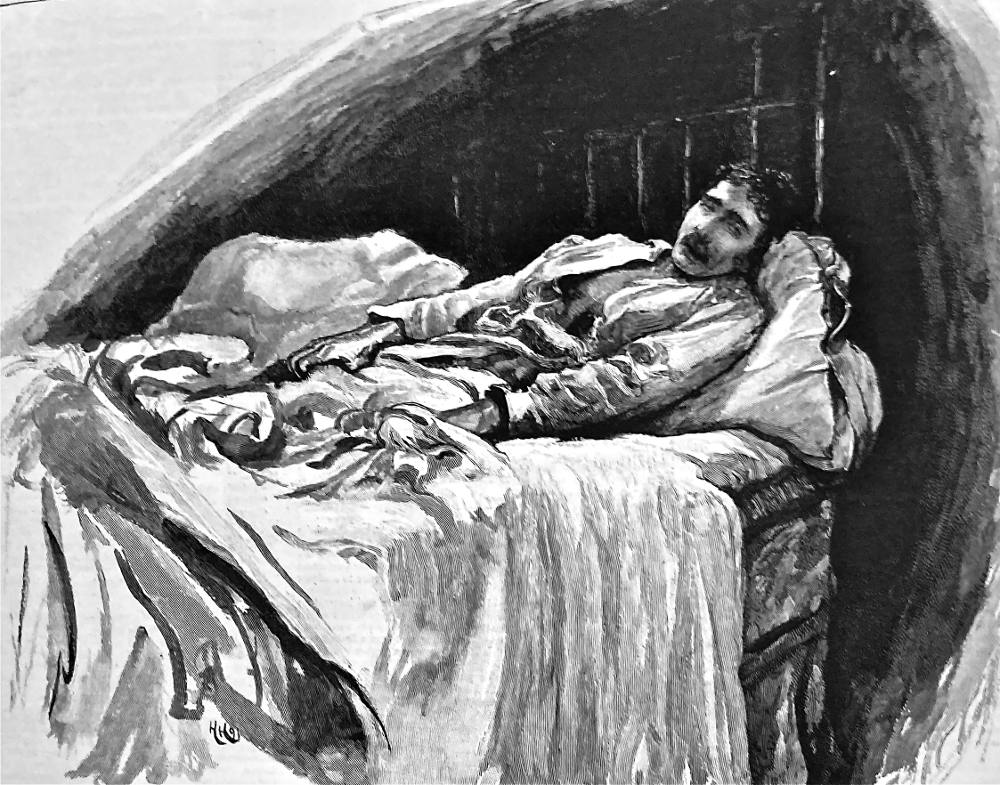
He lay on his back as if he had scarcely moved. by Hubert Von Herkomer. Plate 23 [19 December 1891] from the monthly serialisation of Thomas Hardy's Tess of the Durbervilles in the London Graphic, page 725. This title is not a direct quotation, but closely resembles the discovery of Alec D'Urberville's corpse at the end of this twenty-third instalment and of Ch. LVI (p. 727, one-third of the way down column 1). Half-page, horizontal: 18.2 cm high by 22.5 cm wide (8 ⅝ inches by 12 inches wide). [Click on the illustration to enlarge it.]
Passage Illustrated: D'Urberville Dead, Haggard, and Helpless
“My good God, the gentleman in bed is dead! I think he has been hurt with a knife — a lot of blood has run down upon the floor!”
The alarm was soon given, and the house which had lately been so quiet resounded with the tramp of many footsteps, a surgeon among the rest. The wound was small, but the point of the blade had touched the heart of the victim, who lay on his back, pale, fixed, dead, as if he had scarcely moved after the infliction of the blow. In a quarter of an hour the news that a gentleman who was a temporary visitor to the town had been stabbed in his bed, spread through every street and villa of the popular watering-place. [Book Seventh, "Fulfilment," Chapter LVI, 727: end of serial instalment]
Commentary: Just whose body is this?
This sixth and final plate by Herkomer would seem to have a somewhat unwieldy title (and one that is not a direct quotation from the text). Perhaps he was trying to avoid the sexual implication of penetration in such words as "wounds," "point," and "infliction." Certainly this amended caption is less lurid, and therefore more suitable for a family magazine, just as Herkomer's minimizing the blood on the victim's chest makes the study of the dead man less violent and graphic. Surprisingly, then, Arlene Jackson in Illustration and the Novels of Thomas Hardy has misidentified the corpse as the living Angel Clare, perhaps when he awakes in bed, pondering in which Sandbourne house opposite his hotel Tess must be staying.
As we have seen already in They reached the cloister-garth, where were the graves of monks. Upon one of these graves he carefully laid her down (17 October), Herkomer has made the two, Angel Clare and Alec D'Urberville, simlar physical types with uncannily similar faces. Nevertheless, that the comatose or dead figure is Angel rather than Alec is improbable, for an experienced magazine illustrator such as Herkomer would not likely have by-passed one of the story's most sensational moments for something so minor as Angel's awakening at the parsonage after returning from Brazil, or that when he sits up in bed pondering where Tess must be. One wonders how many among the original serial readers were led into the same confusion. But there is nothing optimistic or forward looking about the rigid figure in the nightgown and the darkened room as "He lay on his back as if he had scarcely moved" (725).
Only one scene remains in the narrative pictorial series, Daniel Wehrschmidt's 26 December plate Something seemed to move on the verge of the dip eastward, realizing the moment when Angel becomes aware that the police have encircled him Tess at Stoneghenge, a highly dramatic moment to which Herkomer's talents would perhaps have been better suited. Thus concludes Herkomer's program of six plates in a series of twenty-five, the others being D. A. Wehrschmidt (eight), Ernest Borough Johnson (six), and Joseph Syddall (five).
Other Illustrations by Hubert von Herkomer
- There stood her mother, amid the group of children, hanging over the washing tub (4 July)
- "This here stooping do fairly make my back open and shut," exclaimed the dairy man. (29 August)
- "You be going to marry him?" asked Marian. (3 October)
- They reached the cloister-garth, where were the graves of monks. Upon one of these graves he carefully laid her down (17 October)
- On going up to the fire to throw a pitch of dead weeds upon it, she found that he did the same on the other side. The fire flared up, and she beheld the face of D'Urberville. The unexpectedness of his presence, the grotesqueness of his appearance in a gathered smock-frock such as was now worn only by the most old-fashioned of the labourers, had a ghastly comicality that chilled her as to its bearing. D'Urberville emitted a low, long laugh. (5 December)
Scanned image and text by Philip V. Allingham. Formatting by George P. Landow. [You may use this image without prior permission for any scholarly or educational purpose as long as you (1) credit the person who scanned the image and (2) link your document to this URL in a web document or cite the Victorian Web in a print one.]
Bibliography
Allingham, Philip V. "The Original Illustrations for Hardy's Tess of the D'Urbervilles Drawn by Daniel A. Wehrschmidt, Ernest Borough-Johnson, and Joseph Sydall for the Graphic (1891)." The Thomas Hardy Year Book, No. 24 (1997): 3-50.
Allingham, Philip V. "Six Original Illustrations for Hardy's Tess of the D'Urbervilles Drawn by Sir Hubert Von Herkomer for the Graphic (1891)." The Thomas Hardy Journal, Vol. X, No. 1 (February 1994): 52-70.
Hardy, Thomas. Tess of the D'Urbervilles in the Graphic, 1891, 4 July-26 December, pp. 11-761.
Hardy, Thomas. Tess of the D'Urbervilles: A Pure Woman. Vol. I. The Wessex Novels.London: Osgood, McIlvaine, 1897.
Jackson, Arlene M. Illustration and the Novels of Thomas Hardy. Totowa, NJ: Rowman and Littlefield, 1981.
Vann, J. Don. "Tess of the D'Urbervilles in the Graphic, 4 July — 26 December 1891." Victorian Novels in Serial. New York: MLA, 1985, pp. 88-89.
Created 14 December 2000
Last modified 3 May 2024